I’ve always had a soft spot for Malaysian desserts, simply because they’re quite similar to the desserts we have in the Philippines. Even if it’s my first time trying a dessert in Malaysia, I’m almost sure how it’ll taste just from looking at it.
Ais kacang is the Malaysian equivalent of halo-halo. Turon is reminiscent of pisang goreng while kuih and kakanin are like Malaysian and Filipino relatives who grew up in two different countries. They’re clearly different but still alike in so many ways.
Sweet things always bring a sense of comfort. So does familiarity, which is why I enjoy trying Malaysian desserts. They may be foreign but they still taste like home.
If you have a soft spot for the sweeter things in life, then here are 25 Malaysian desserts that you need to try in Kuala Lumpur, Penang, or any other city in Malaysia.
MALAYSIAN DESSERTS QUICK LINKS
If you’re planning a trip to Malaysia and want to learn more about the local cuisine, then you may be interested in joining a food tour or taking a cooking class.
TOURS & OTHER SERVICES
- Food Tours: Food and Market Tours in Malaysia
- Cooking Classes: Cooking Classes in Malaysia
- eSIM: Malaysia eSIM
Save This on Pinterest!
No time to read this guide on traditional Malaysian desserts? Click on the save button and pin it for later!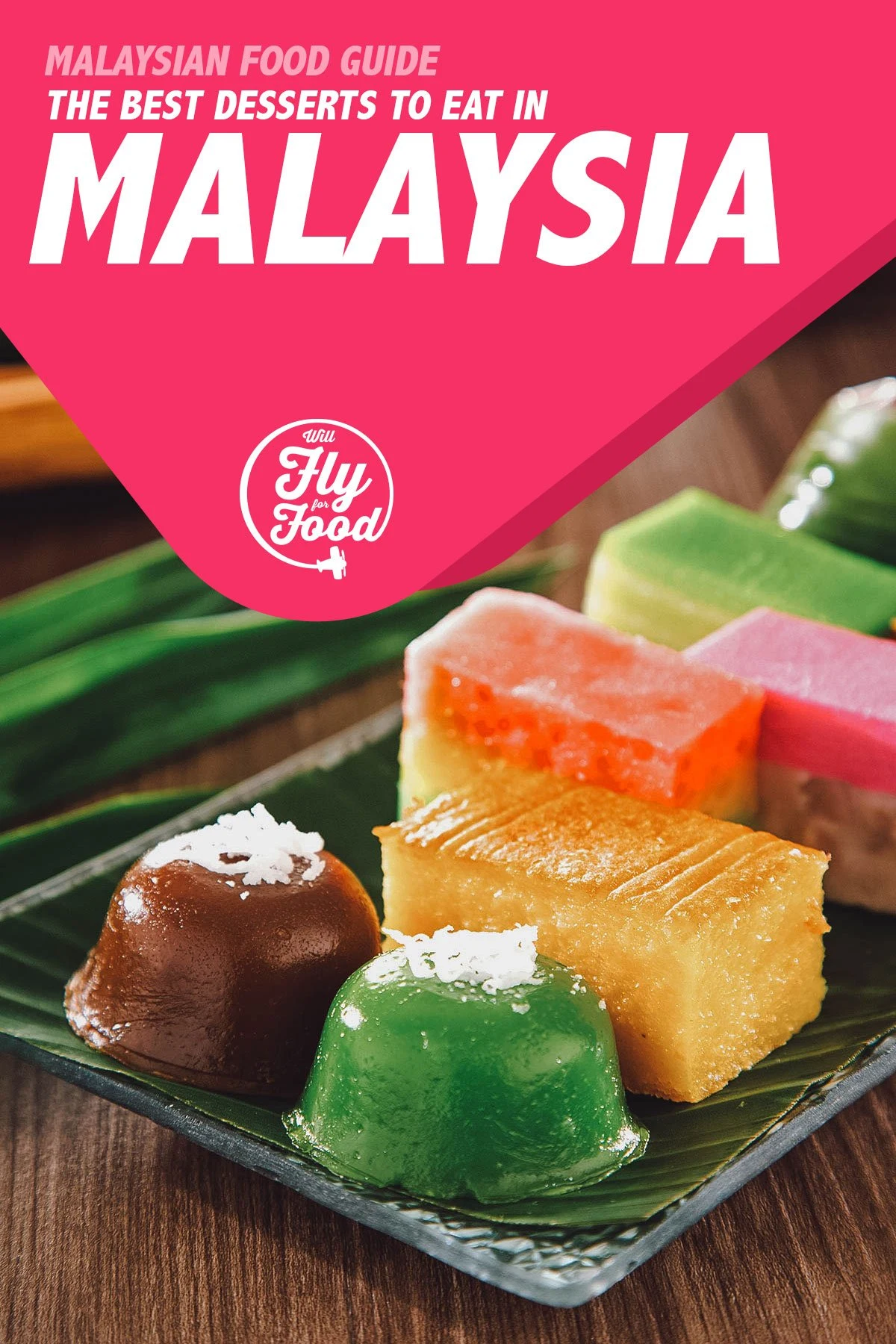
Photo by tehcheesiong
THE BEST MALAYSIAN DESSERTS
1. Ais Kacang
As described, I like to think of ais kacang as the Malaysian relative of Filipino halo-halo. It literally means “bean ice” and refers to a refreshing Malaysian shaved ice dessert topped with a smorgasbord of colorful ingredients.
In Malaysia, ais kacang is also commonly referred to as ABC. It’s short for air batu campur which means “mixed ice”. Originally, ais kacang was made with just shaved ice and red beans but today, it’s made with a plethora of different ingredients like sweet corn, grass jelly, palm seed, roasted peanuts, cendol, and ice cream. Condensed, evaporated, or coconut milk is drizzled on top along with one or more syrups before serving.
Ais kacang is equally popular in Brunei and in Singapore where it’s known as ice kachang.
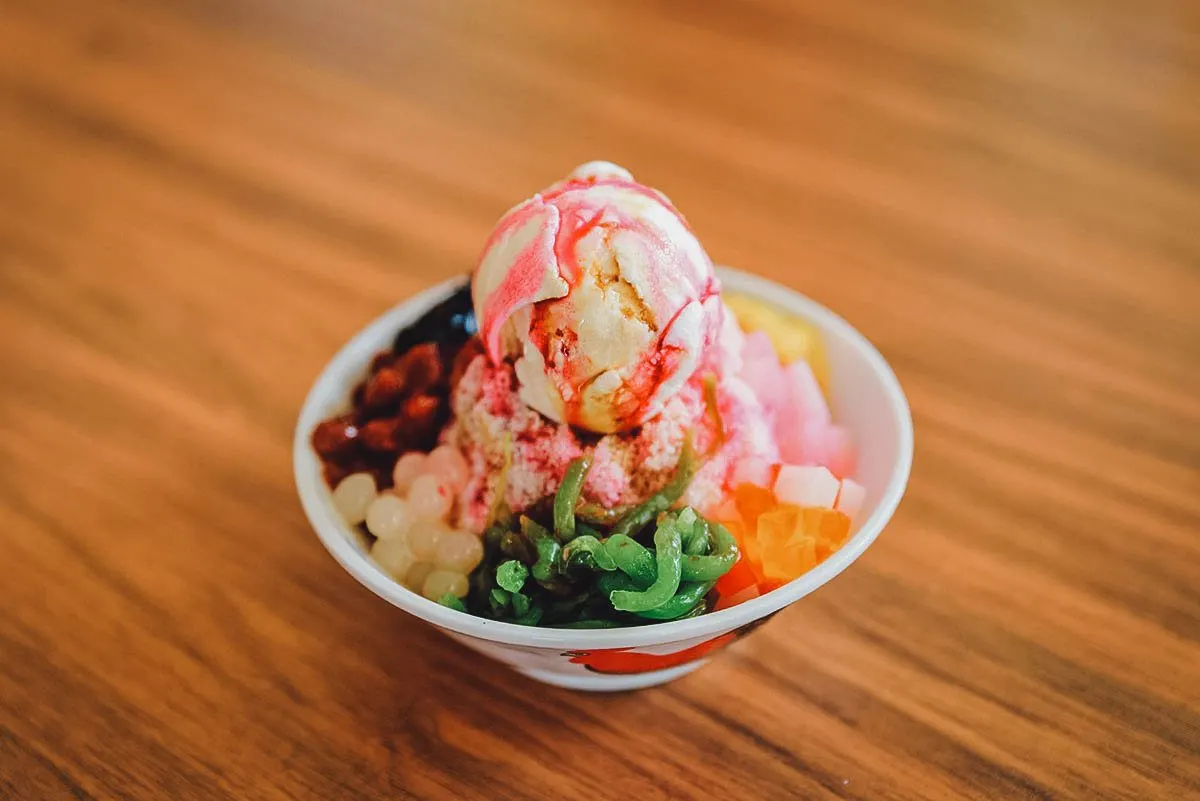
Photo by spukkato
2. Cendol
Cendol could very well be my favorite Malaysian dessert. Like ais kacang, it’s a refreshing dessert made with shaved ice, but with a more specific set of ingredients. Its key ingredients are coconut milk, palm sugar syrup (gula melaka), and these green rice flour jelly noodles from where the dessert gets its name.
Cendol is popular in many countries throughout Southeast Asia like Indonesia, Cambodia, Thailand, and Vietnam. It can be prepared with different ingredients depending on where it’s from but in Malaysia, it’s typically made with cendol, shaved ice, coconut milk, palm sugar syrup, and sweetened red beans.
I absolutely love the earthy sweetness of gula melaka (palm sugar) which is why cendol is one of my favorite Malaysian desserts.
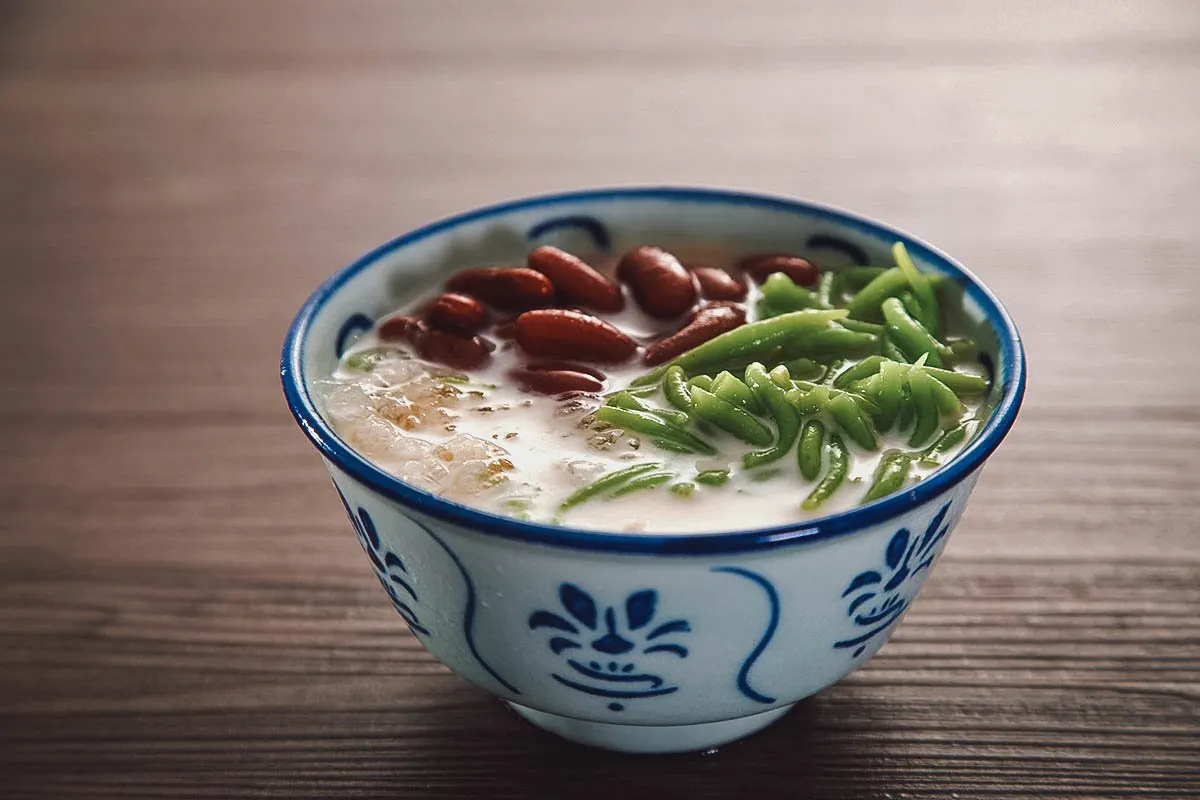
Photo by tehcheesiong
3. Bubur Cha Cha
Bubur cha cha refers to a sweet dessert soup made with coconut milk and a mix of different ingredients like sago pearls, purple sweet potatoes, bananas, yams, grated coconut, coconut cream, and pandan leaves. It can be served hot or cold and can be eaten for breakfast or for dessert.
Bubur cha cha is one of the most well-known Peranakan/Nyonya desserts. It’s common in parts of Southeast Asia where there’s a sizeable Peranakan population like Malaysia, Indonesia, Singapore, and Phuket.
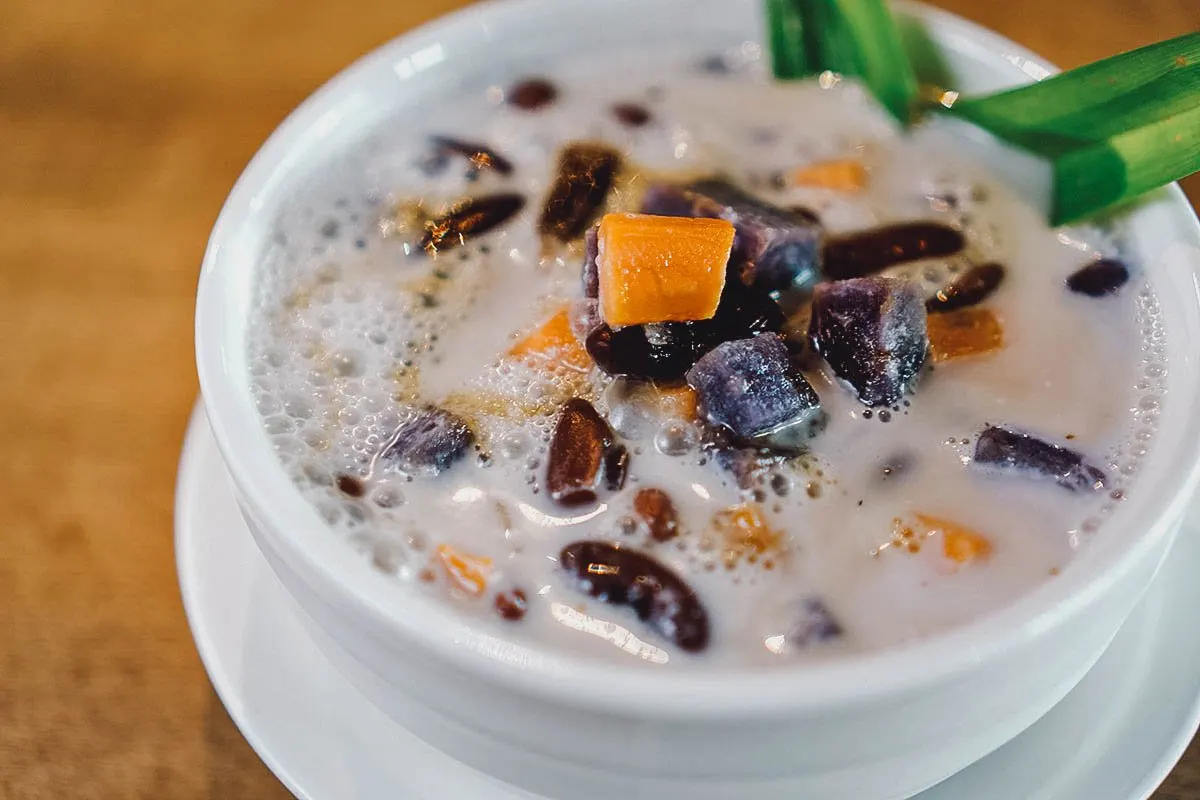
Photo by pixelbleed
4. Bubur Pulut Hitam
Bubur pulut hitam refers to a type of Indonesian and Malaysian dessert porridge or pudding made with black glutinous rice (pulut hitam), coconut milk, pandan leaves, and palm sugar. Some recipes make it with red beans as well, the same red adzuki beans used in Chinese hong dou tang or red bean soup.
Like many Southeast Asian sweet porridges, bubur pulut hitam is a popular Malysian dessert that can be eaten at any time of the day.
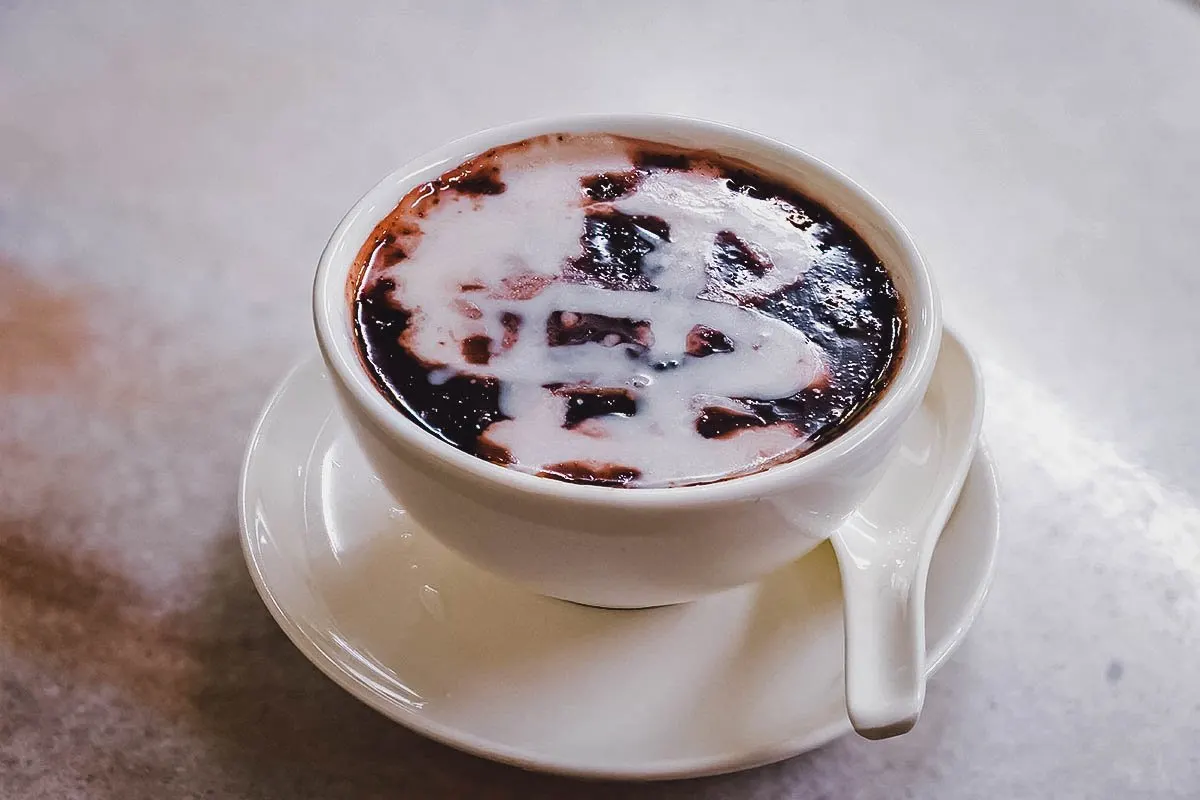
Photo by nawadoln
5. Tang Yuan
I recently wrote about tang yuan in this article about Taiwanese desserts. It refers to a Chinese dessert that’s traditionally prepared to celebrate Dongzhi or the Winter Solstice Festival in many countries throughout East Asia and Southeast Asia.
Tang yuan is a type of sweet soup made with glutinous rice balls served in a hot ginger- and pandan-infused syrup. The balls can be made in different sizes and colors and can be filled or unfilled. When filled, they’re often stuffed with black sesame paste or ground peanuts.
As you may know, symbolism is important in Chinese culture. Long, unbroken noodle strands symbolize longevity while these round sticky rice balls represent togetherness, completeness, and unity.
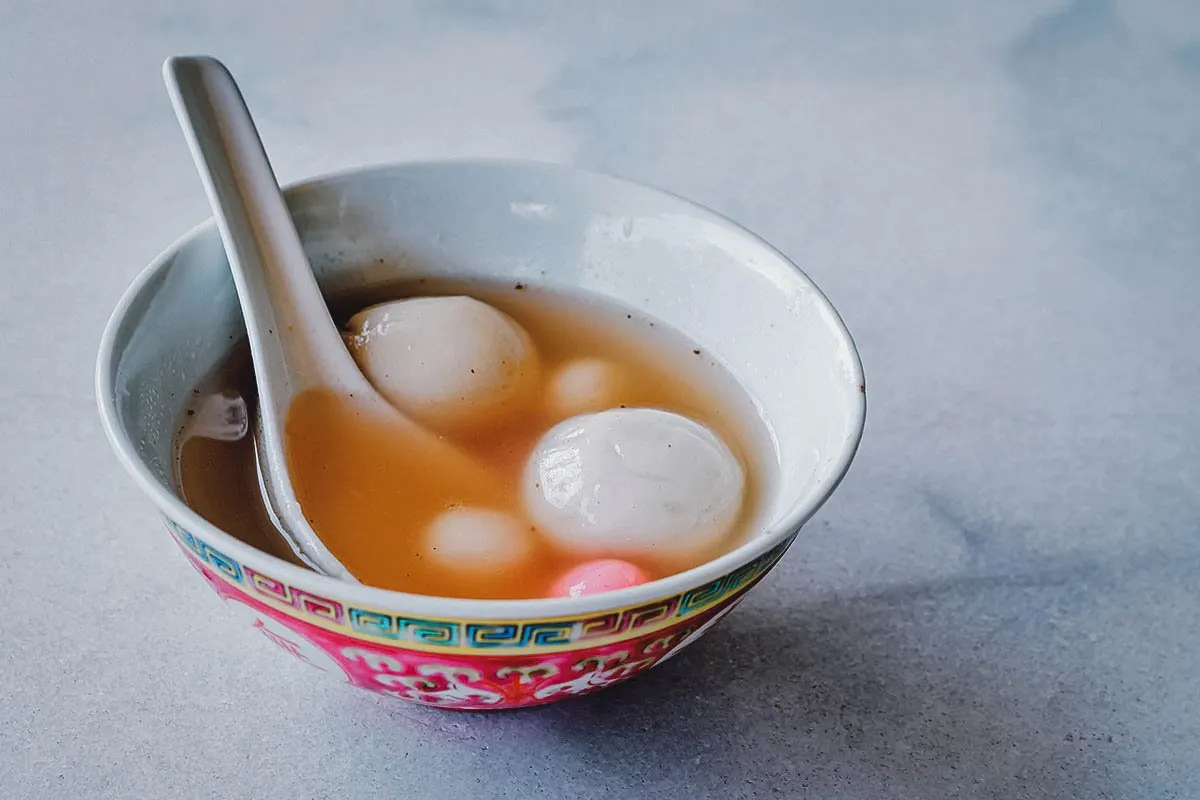
Photo by [email protected]
6. Sago Gula Melaka
Sago gula melaka is another of my favorite Malaysian desserts. It’s a simple but delicious pudding made with sago pearls, palm sugar syrup (gula melaka), coconut milk, and pandan leaves.
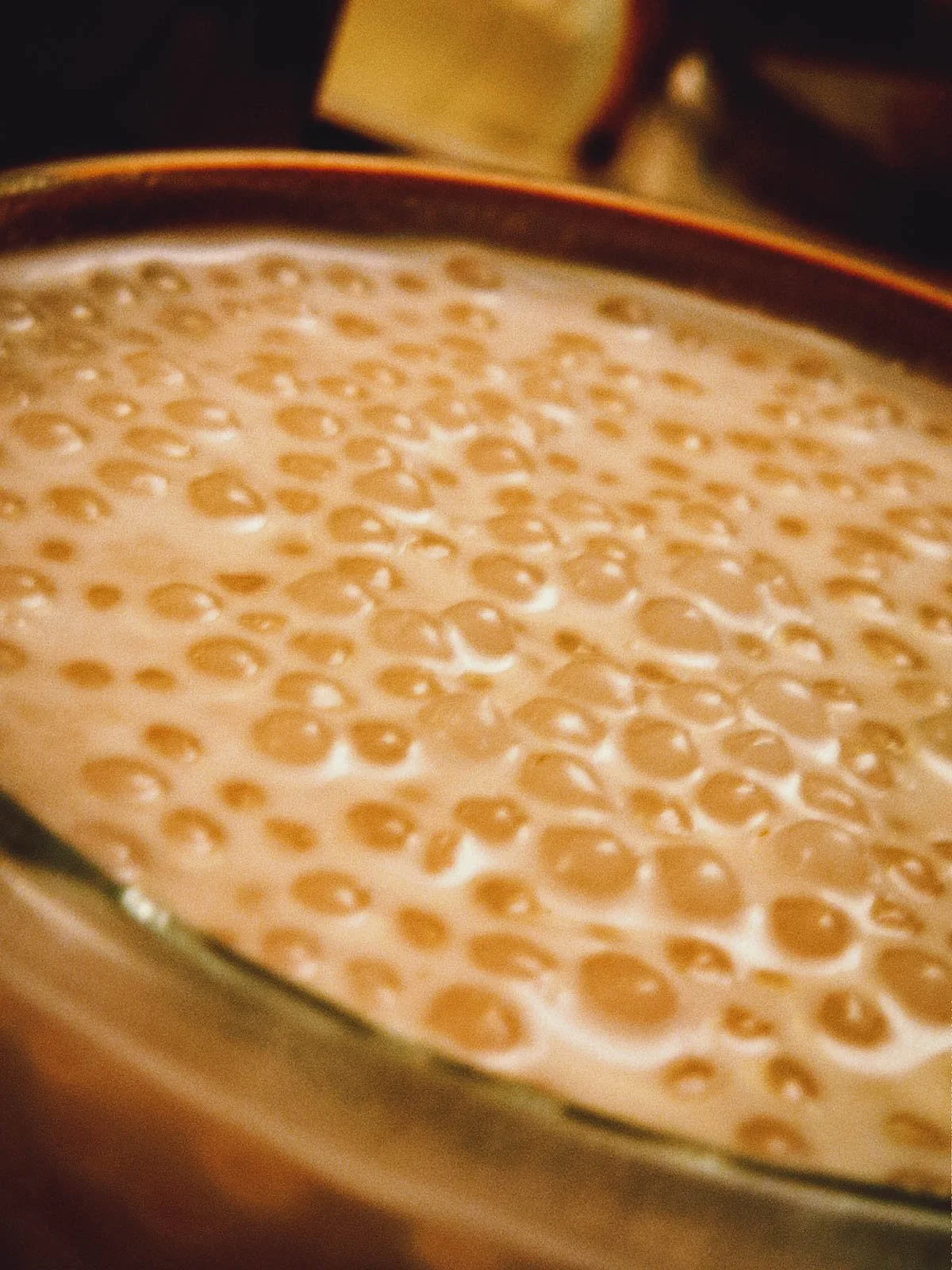
Enfrijoladas by yeong suejan, used under CC BY 2.0 / Processed in Photoshop and Lightroom
7. Apam Balik
If you like murtabak, then you need to try apam balik. It’s a sweet version of murtabak that’s popular in Malaysia, Indonesia, Singapore, and Brunei.
Apam balik is made with a batter consisting of flour, eggs, coconut milk, sugar, and baking soda. The batter is cooked in a round pan and slathered with butter before being topped with a variety of different ingredients like cheese, jam, condensed milk, bananas, crushed peanuts, and chocolate.
Before serving, the pancake is folded in half and cut into smaller portions to make it easier to eat.
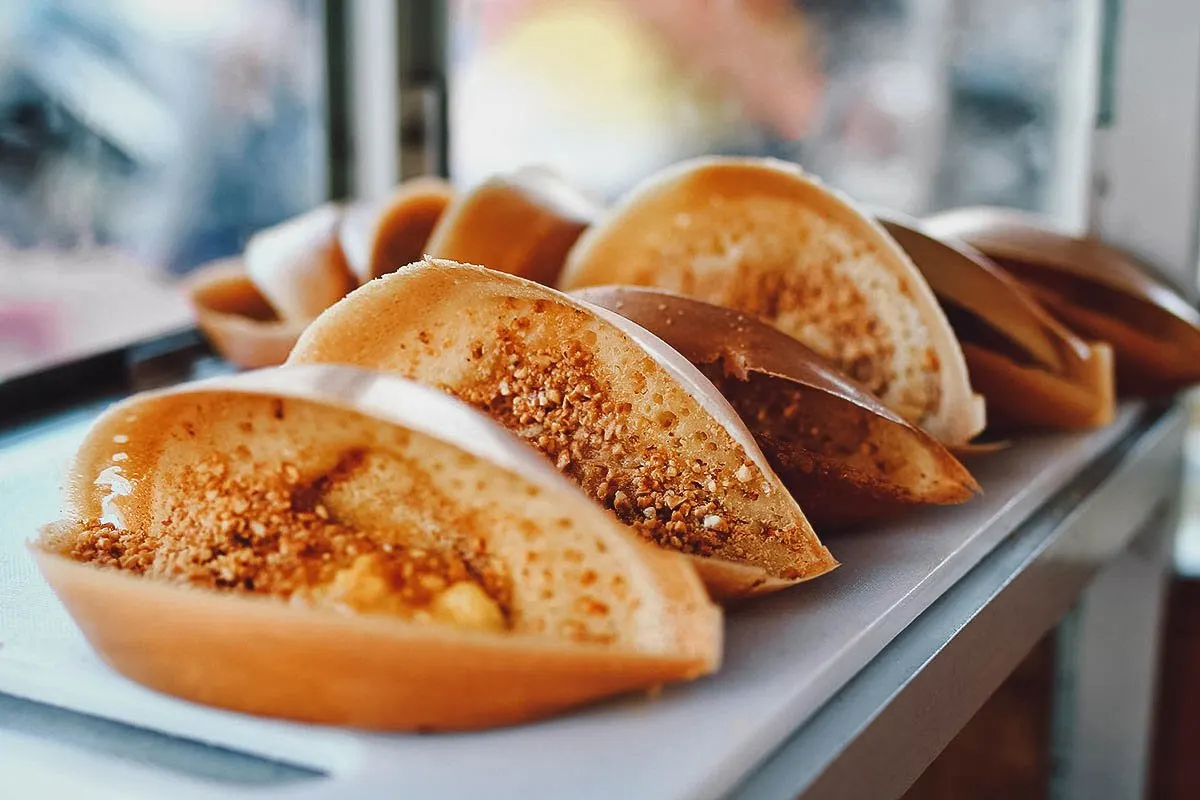
Photo by Zaitceva
8. Roti Tisu
Roti canai or roti prata is one of my favorite types of Malaysian flatbread. Originally from India and popular in many countries throughout Southeast Asia, it refers to a family of flaky flatbreads that are typically eaten with curry or stuffed with a variety of savory and sweet ingredients. The aforementioned murtabak is one type of stuffed roti canai.
Roti tisu is a sweet, paper-thin version of roti canai. Also known as roti helikopter (helicopter bread), it’s much thinner and crispier than your average roti canai. It’s typically shaped in a cone and served with sweet ingredients like sugar, condensed milk, kaya (coconut jam), or ice cream.
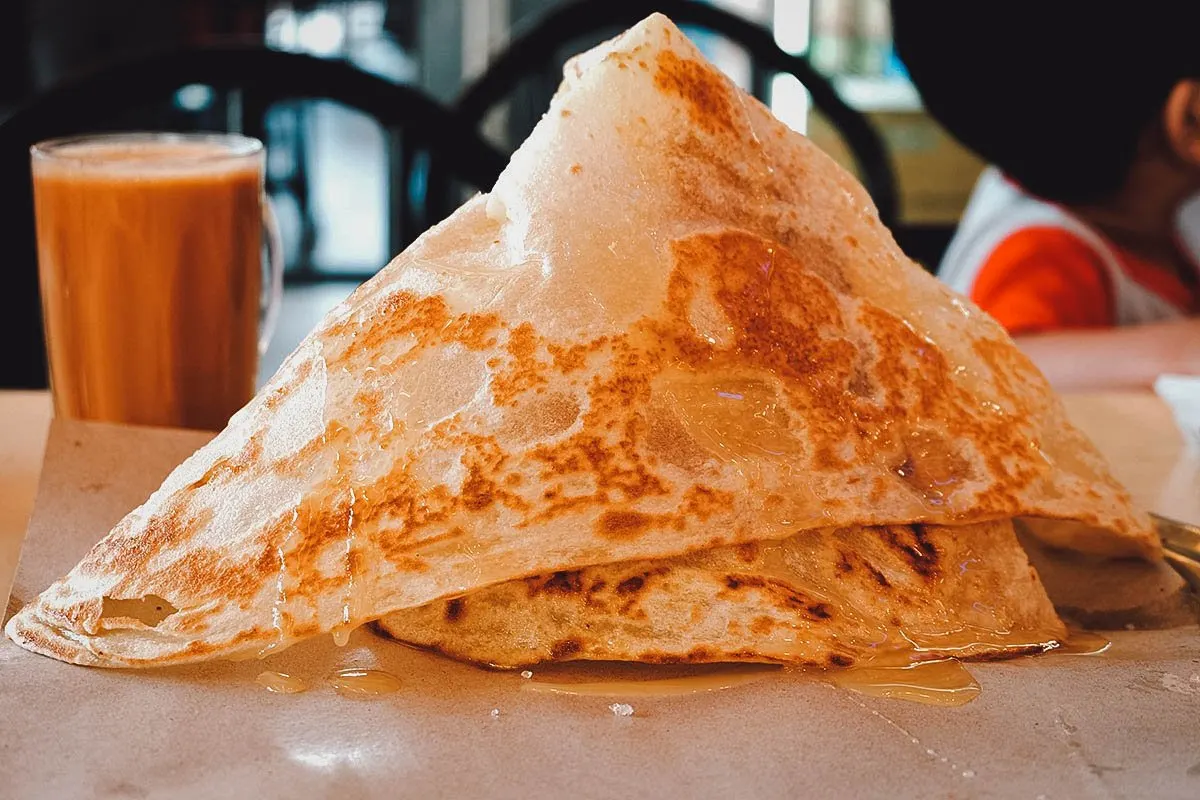
Photo by Najmi9590
9. Pisang Goreng
Pisang goreng refers to Malaysian-style deep-fried banana fritters. They’re made with plantains that are coated in batter and then deep-fried. They remind me of Filipino turon, except the Filipino version is wrapped in lumpia wrapper instead of being coated in batter.
These delicious Malaysian deep-fried bananas can be eaten as is or served with sweet ingredients like condensed milk, brown sugar, cinnamon, or ice cream.
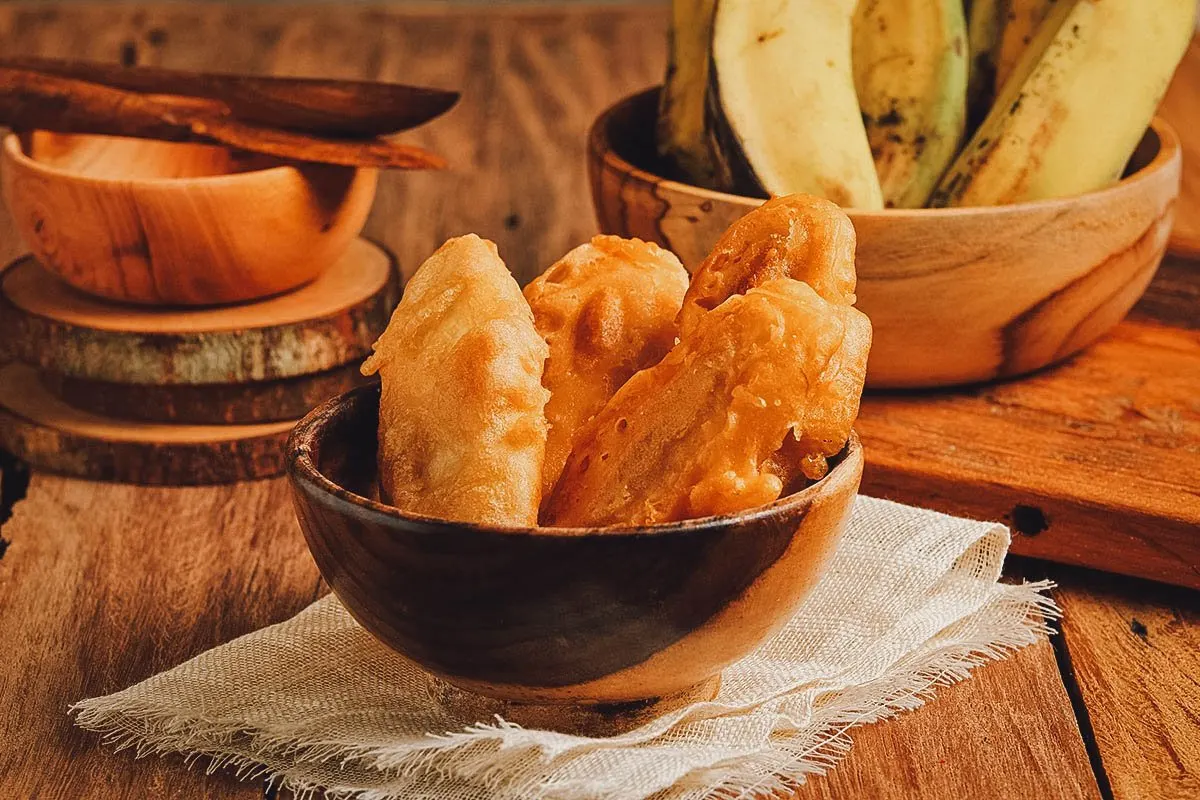
Photo by kalkasandi.gmail.com
10. Muah Chee
From the name, can you guess what this next Malaysian dessert is like? Muah chee is basically the Chinese version of Japanese mochi. Popular in Malaysia, Indonesia, and Singapore, it’s a chewy dessert or snack made with glutinous rice flour coated with peanut powder, sugar, and toasted sesame seeds.
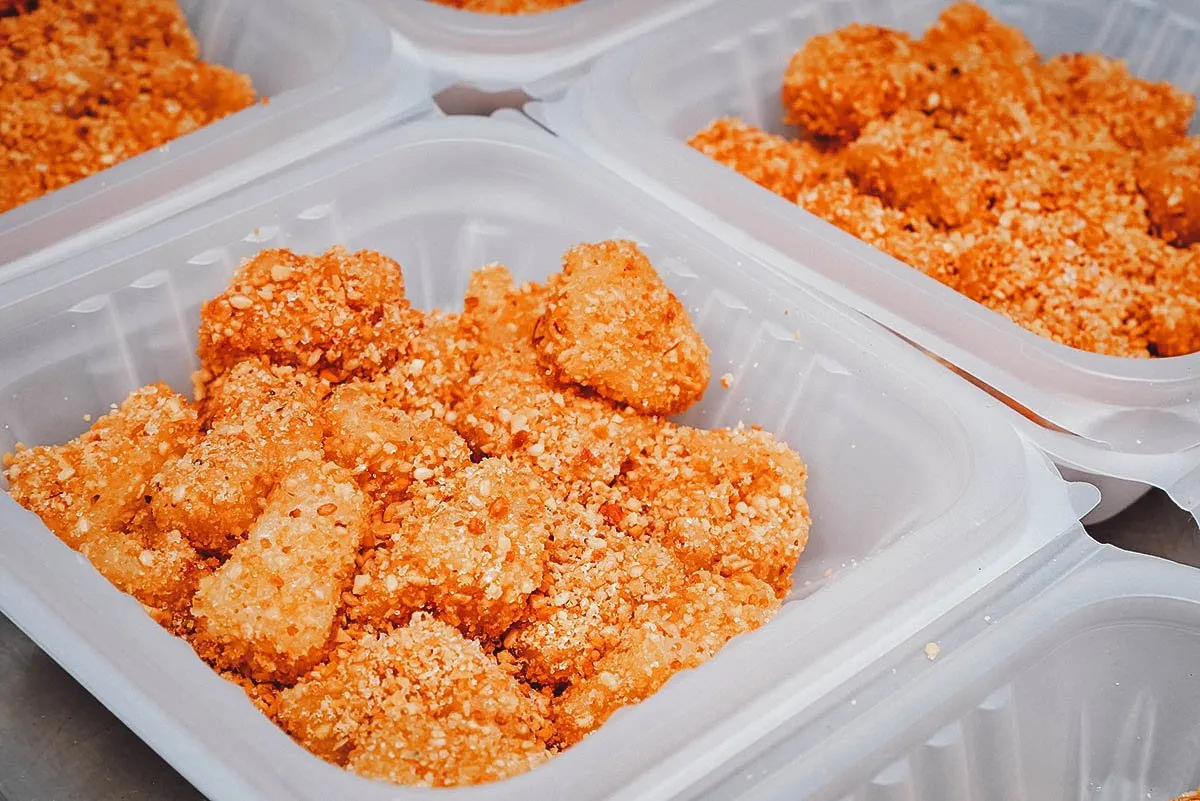
Photo by gracethang
11. Kuih Keria
If you’re a fan of airy donuts, then you need to try kuih keria. It’s a type of Malaysian donut made with mashed sweet potatoes.
Donuts made with all or most of the flour replaced by mashed potatoes tend to be lighter and airier than regular yeast or cake donuts.
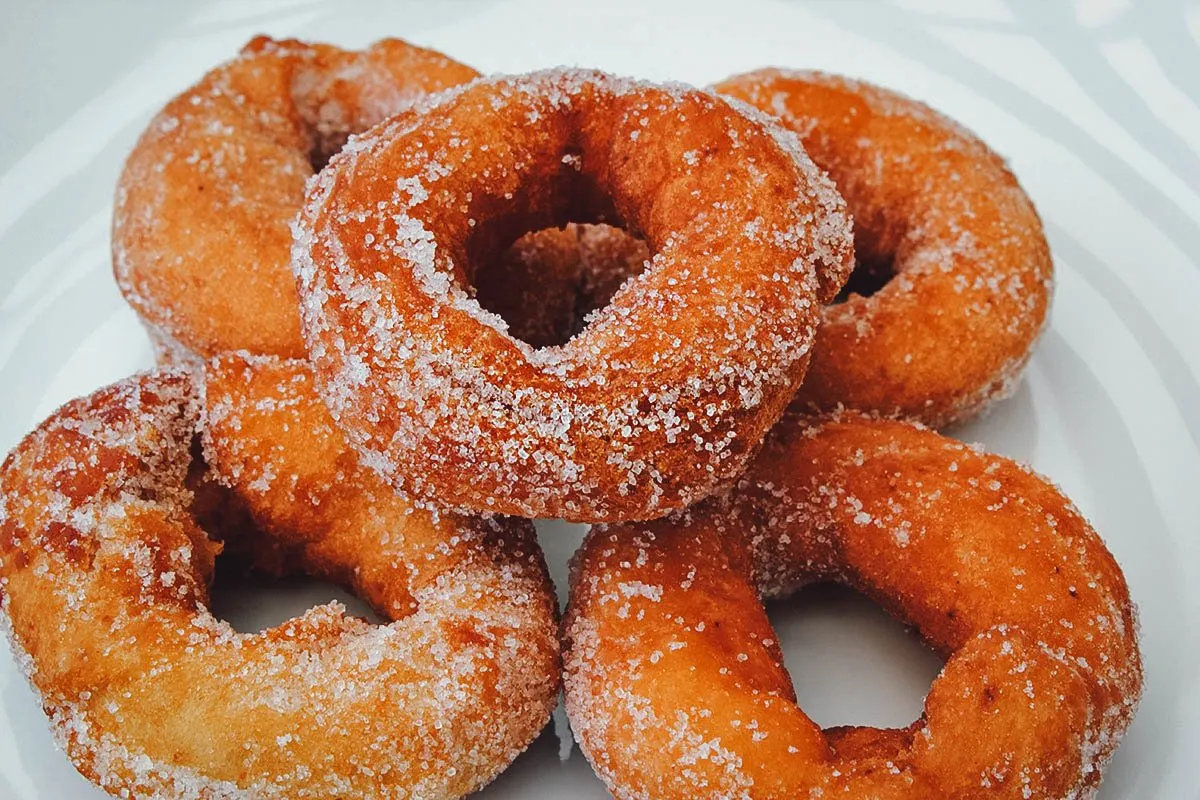
Photo by edu1971
12. Kuih Bahulu
Kuih bahulu is a fun and festive Malaysian egg cake. Like tang yuan, it’s a type of festival food that’s traditionally baked to celebrate Hari Raya Puasa (Eid al-Fitr) and Chinese New Year.
These spongy and eggy sweet treats can be made with just three basic ingredients – eggs, all-purpose flour, and sugar. They’re similar to French madeleines except they aren’t made with any butter.
Kuih bahulu can be baked into different shapes and sizes but the most popular are these small flower-shaped cakes made using flower molds.
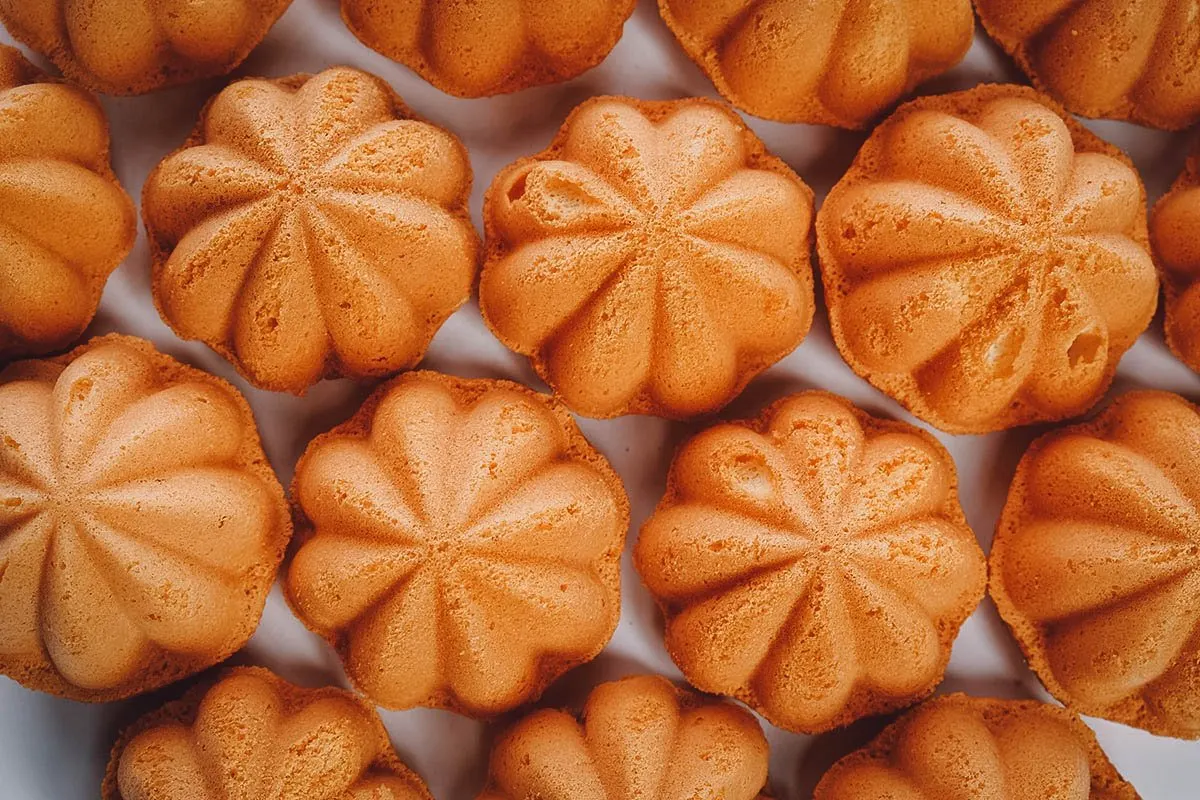
Photo by ahmadart
13. Kuih Loyang
Kuih loyang refers to these thin and crispy Malaysian rosette cookies. Also known as honeycomb or beehive cookies, they’re similar to Norwegian rosettbakkels and are likely a vestige of European influence on Malaysian cuisine.
Kuih loyang cookies are traditionally prepared for Chinese New Year. They’re made using a batter consisting of eggs, coconut milk, rice flour, and sugar. A brass mold is heated in oil before being dipped into the batter. The mold is then re-immersed in hot oil where the batter becomes detached and finishes cooking.
Kuih loyang literally means “brass cake”, likely in reference to the brass mold used to make these cookies. It’s unclear how they made it to Malaysia, though some speculate they may be Dutch in origin.
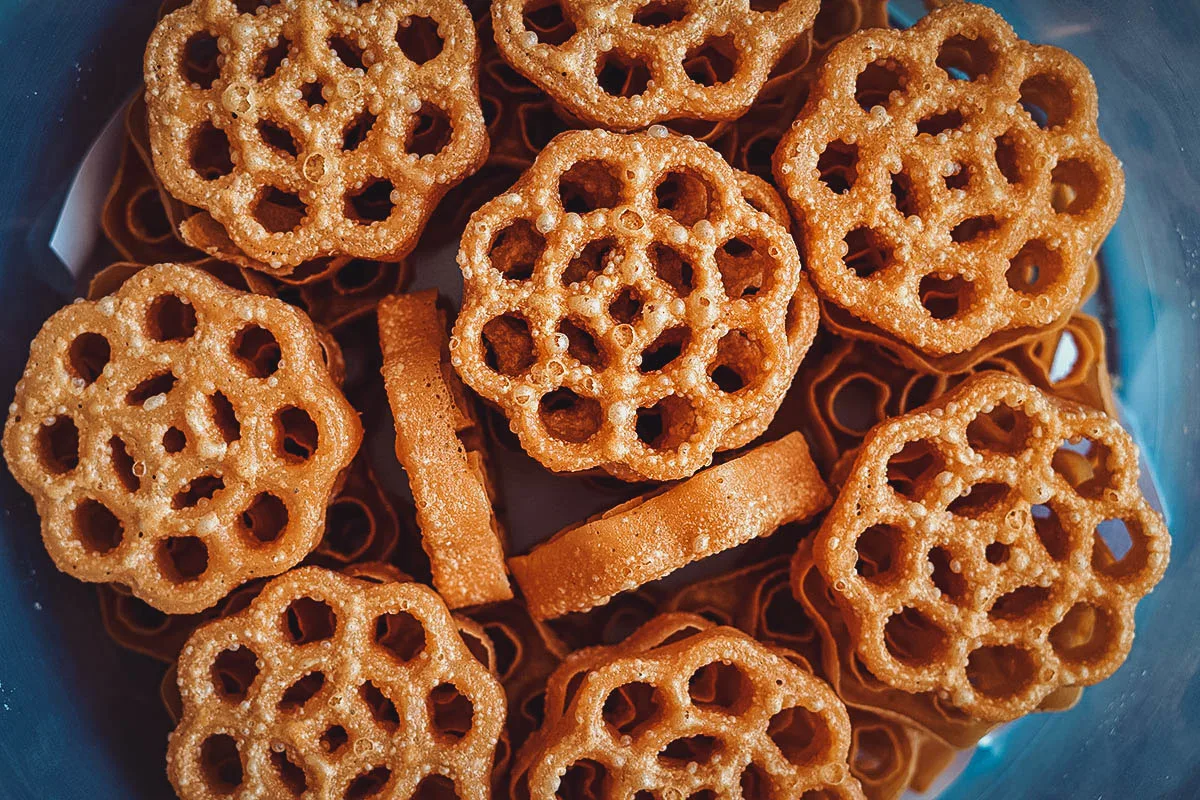
Photo by ellinnur
14. Tau Sar Piah
Tau sar piah are flaky Malaysian pastries made with a savory-sweet mung bean filling. Also known as tambun biscuits, they’re a specialty of Penang and one of the most popular souvenir food items you can bring back from the island.
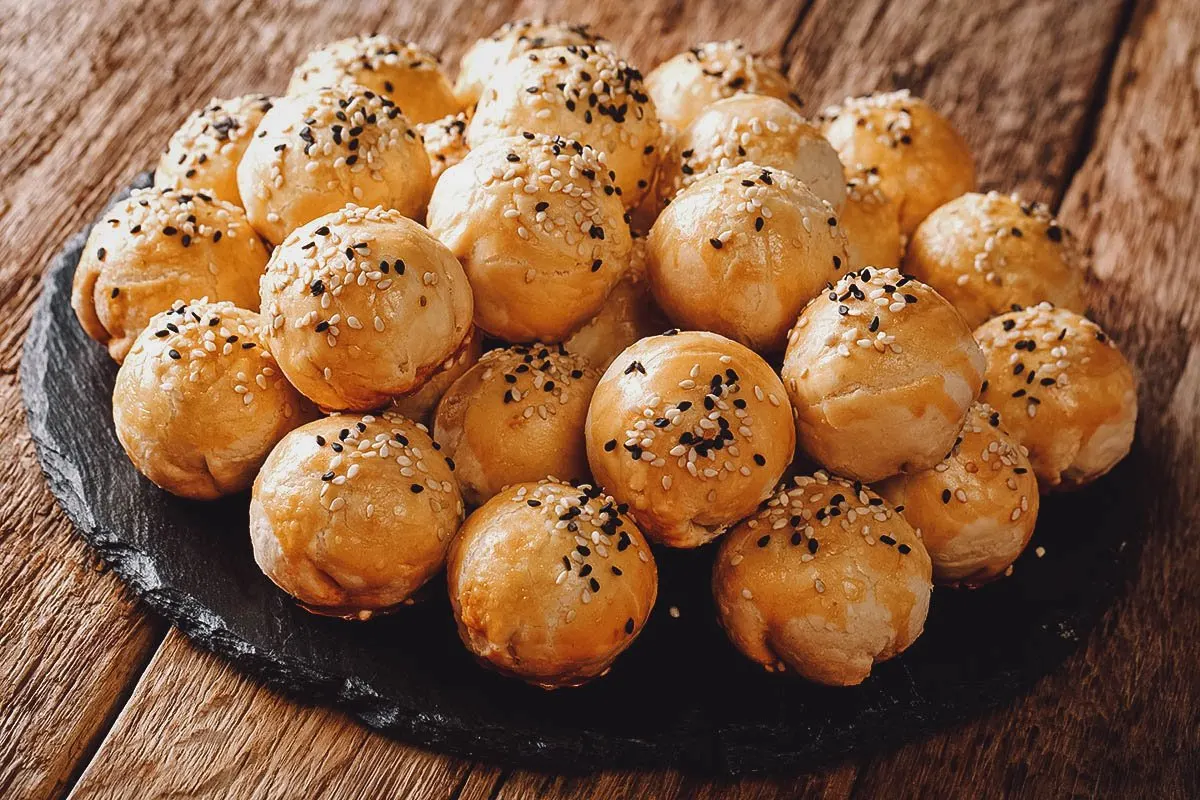
Photo by lenyvavsha
15. Kek Lapis Sarawak
Kek lapis sarawak literally means “Sarawak layer cake”. One look at these colorful layered cakes from Sarawak state and it becomes obvious how they get their name.
Like a few of the desserts on this list, kek lapis sarawak are traditionally made to celebrate special occasions and festivals like Eid ul-Fitr, Deepavali, and Gawai. They often consist of multiple colorful layers and patterns that range from the simple to the elaborate. It’s a meticulous process that requires baking each layer first before putting them all together to form the cake.
Kek lapis sarawak has enjoyed Geographical Indication status since 2010. What this means is that for a Malaysian layered cake to carry the “kek lapis sarawak” label, it needs to be made in Sarawak following the specifications of the Sarawak Layer Cake Manufacturers Association.
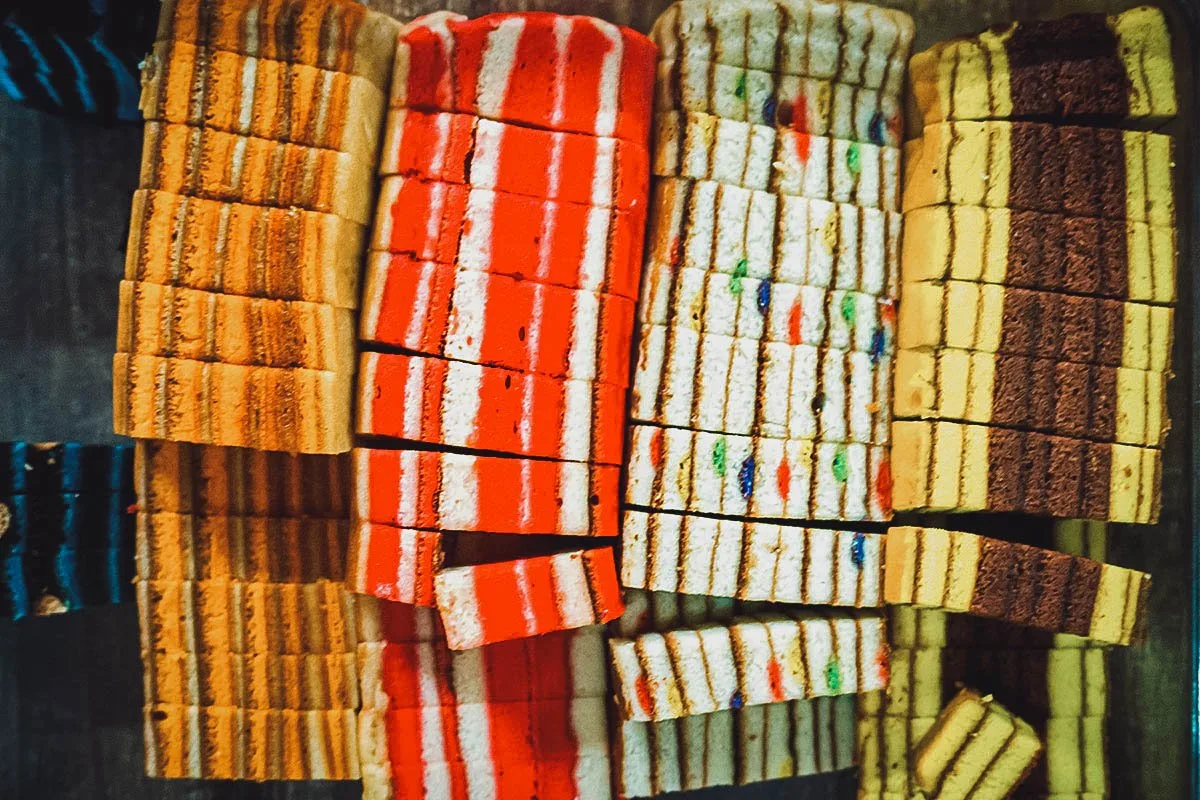
Photo by [email protected]
16. Kek Batik
As you may have noticed from the last dessert, kek means “cake” in Malaysian so kek batik literally means “batik cake”. It’s a type of Malaysian no-bake cake that gets its name from the batik-like pattern formed by broken Marie biscuits.
Kek batik is believed to be an adaptation of the tiffin cake using Malaysian ingredients. It’s a simple cake to make – fudge and biscuits are mixed together and then chilled until set.
Kek batik is typically made with fudge but pictured below is a variation made with pandan called kek batik lumut (moss batik cake).
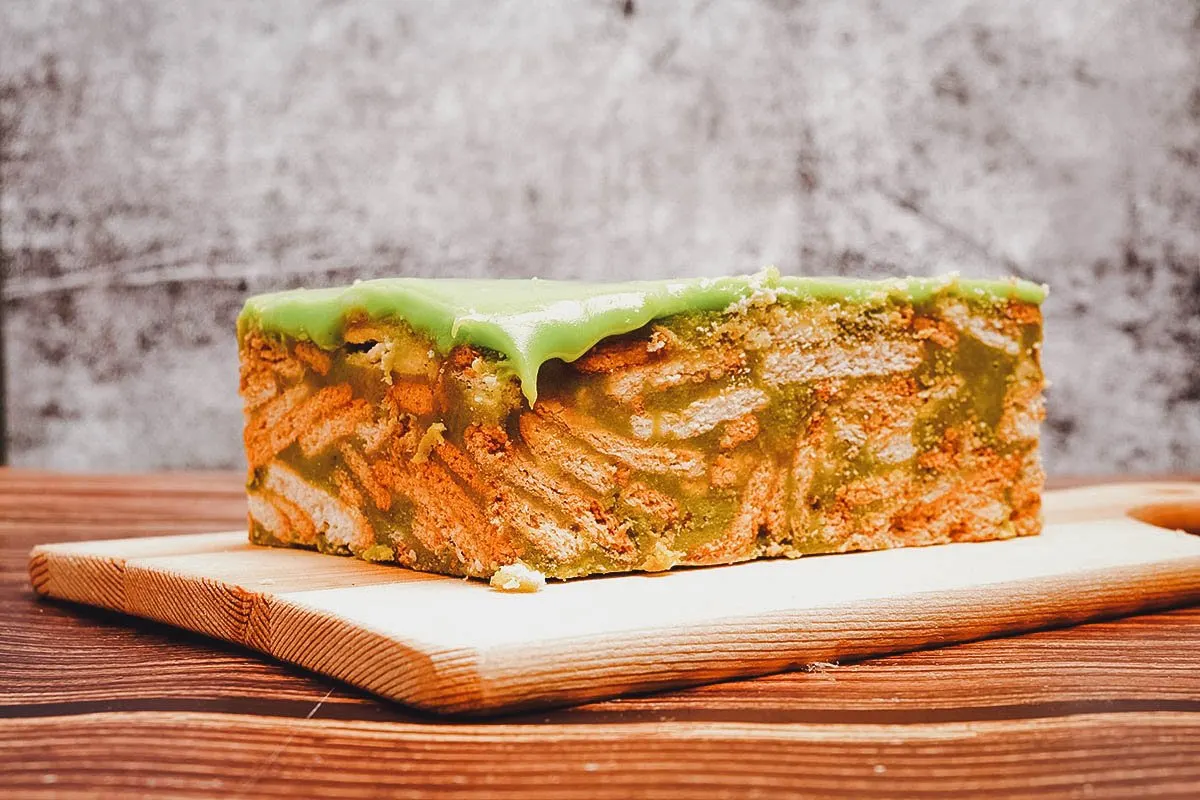
Photo by Najmi9590
17. Kuih Tepung Pelita
If you’re a fan of Thai khanom tako like I am, then you’ll probably enjoy this Malaysian version called kuih tepung pelita. It’s a similar double-layered Malaysian cake served in small, folded banana leaf boats.
Like the Thai version, tepung pelita consists of two layers of rice flour custard – the bottom layer flavored with pandan and the top mixed with thick coconut milk. It’s a smooth and creamy dessert that’s sweet but not too sweet.
Tepung pelita literally means “flour lamp”. The lamp in its name is in reference to a traditional oil lamp that’s said to resemble the dessert’s banana leaf container.
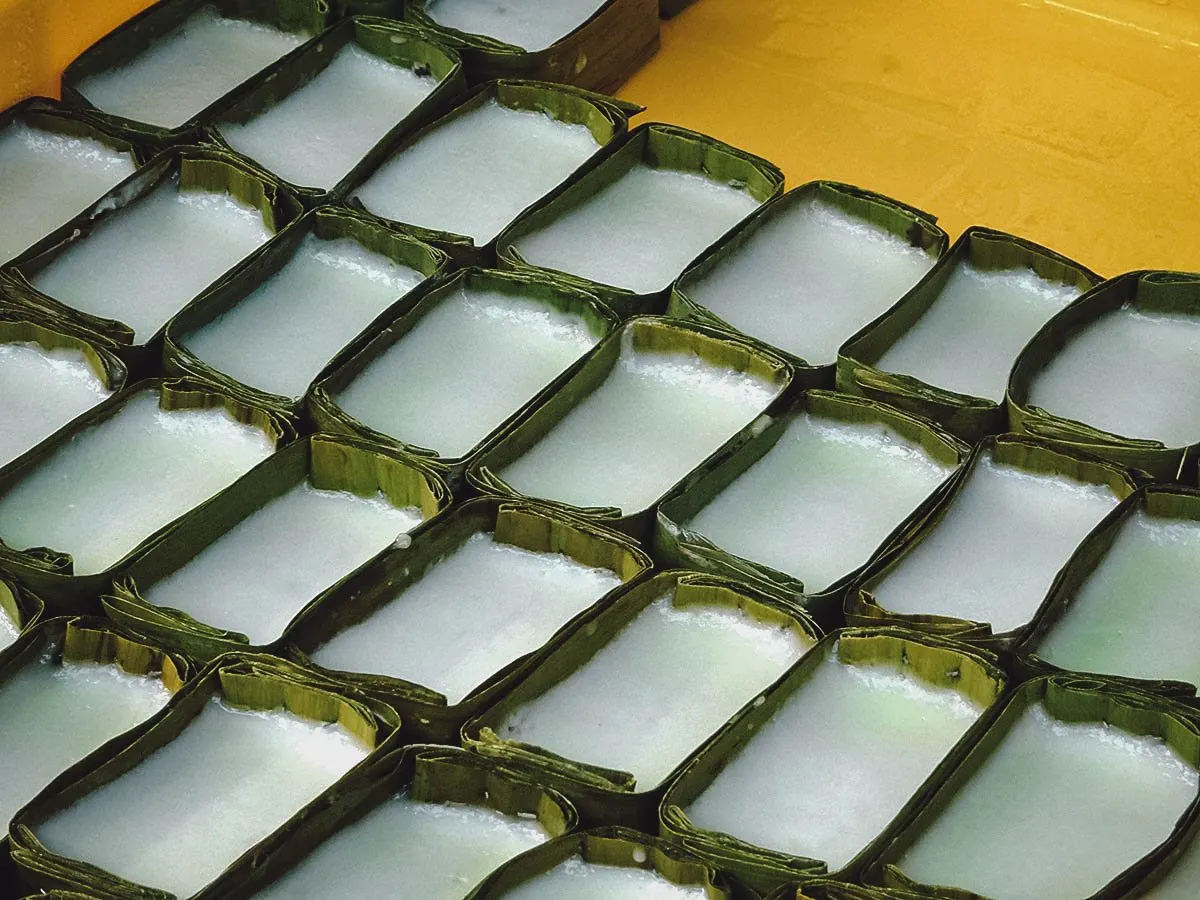
Photo by Aisyaqilumar
18. Kuih Seri Muka
Like tepung pelita, kuih seri muka refers to a double-layered Malaysian dessert made with glutinous rice, coconut milk, and pandan. The bottom layer is made with glutinous rice steamed with coconut milk while the top custard layer gets its green coloring and flavor from pandan juice.
Like many of the rice flour cakes on this list, kuih seri muka is a popular dessert snack in Malaysia, Indonesia, Singapore, and Brunei.
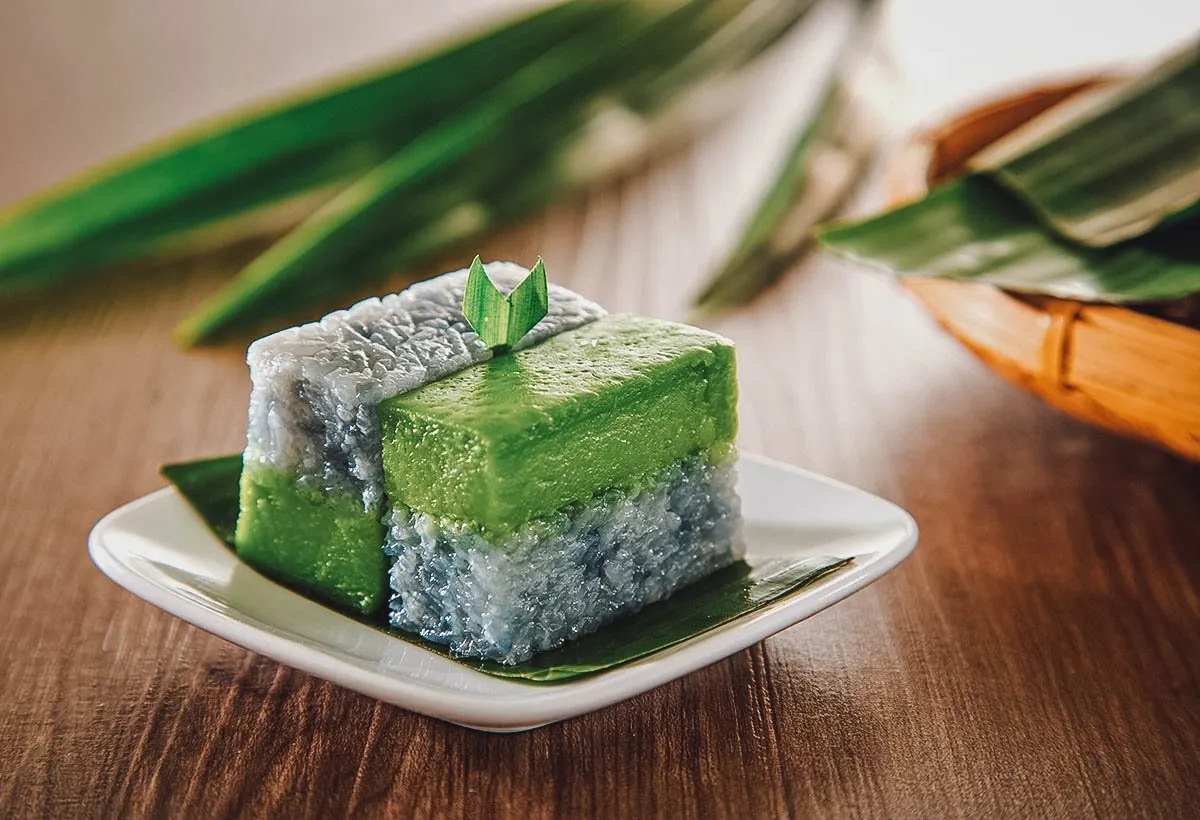
Photo by tehcheesiong
19. Kuih Lapis
Like kek lapis sarawak, kuih lapis gets its name from the many layers that comprise the dessert. Kuih lapis literally means “layer cake” and consists of two or more alternating colored layers of steamed rice flour pudding.
Bouncy and sticky in texture, the layers in kuih lapis are made with rice flour, coconut milk, tapioca flour, sugar, and salt. They get their brightly colored hues from food coloring.
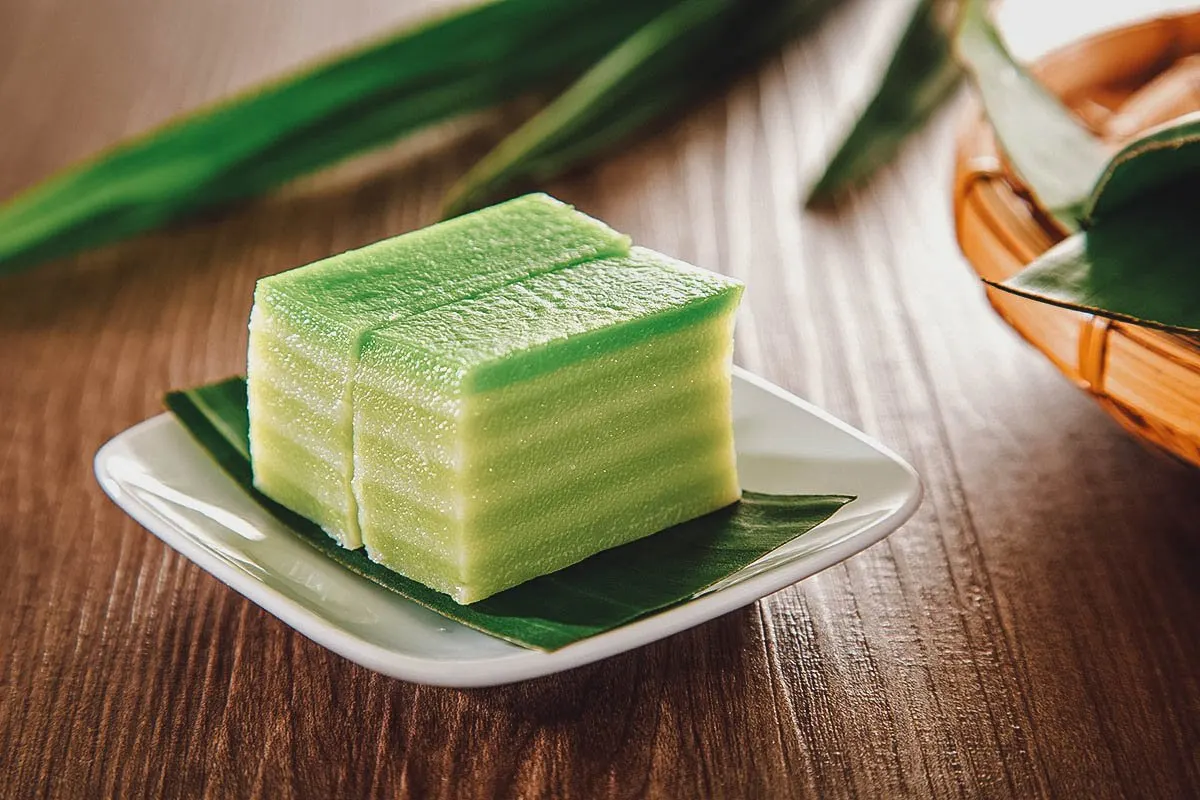
Photo by tehcheesiong
20. Kuih Angku
Kuih angku is one of my favorite types of Malaysian kuih. Round or oval in shape, it’s an eye-catching type of kuih made with mashed sweet potato and glutinous rice flour filled with mung bean paste or sweetened ground peanuts.
Kuih angku is also known as “red tortoise cake”. Its shape is meant to resemble a tortoise shell because the tortoise is considered an auspicious symbol in Chinese culture. The Chinese believe that eating this cake brings good fortune and longevity so it’s often prepared to celebrate important festivals like Lunar New Year.
Aside from the fact that they taste good and have great texture, I like kuih angku because of their bright colors and intricate patterns. They’re made with molds that imprint elaborate designs on the cake’s skin before it’s steamed and served over a piece of banana leaf.
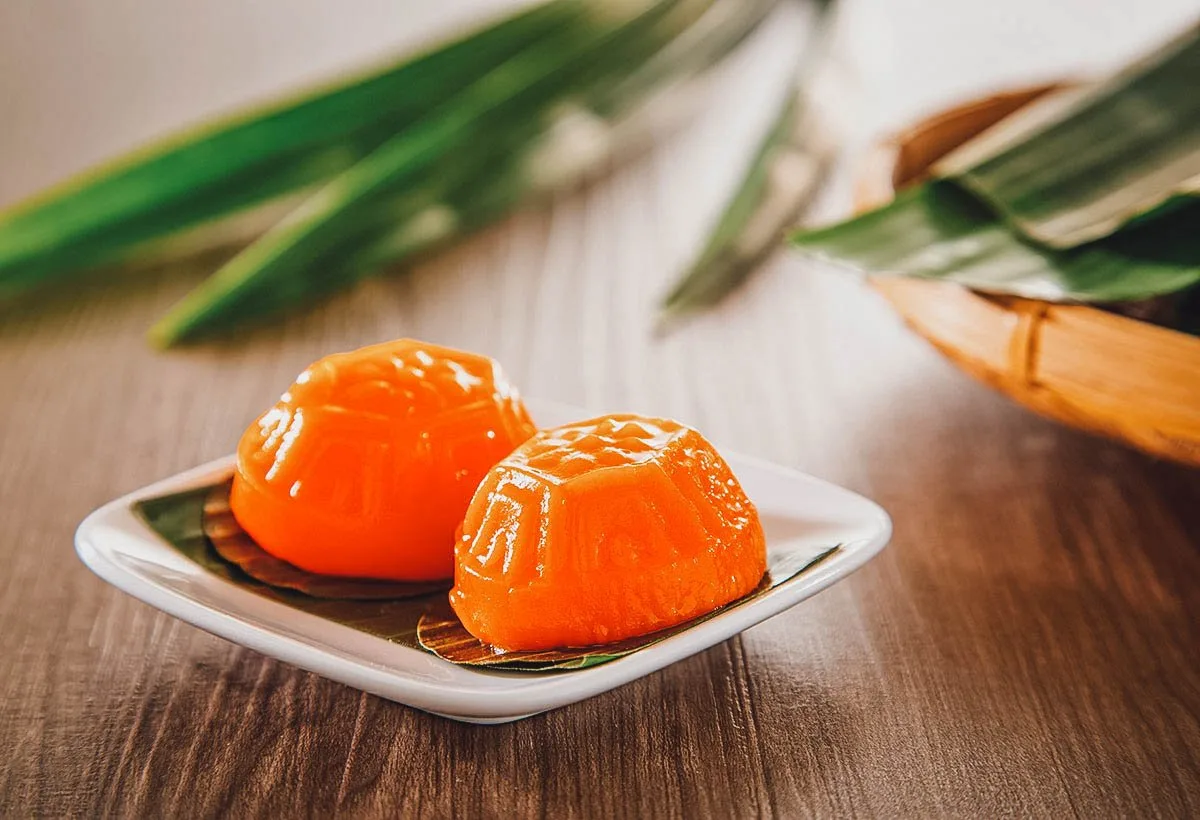
Photo by tehcheesiong
21. Pulut Tai Tai (Pulut Tekan)
Pulut tai tai is a type of kuih made with steamed glutinous rice. Glutinous rice is steamed in coconut milk and then pressed in a wooden frame, hence the dessert’s alternate name pulut tekan which means “pressed glutinous rice”. The dessert is sliced into the desired shapes and slathered with kaya before serving.
Interestingly, the term “tai tai” refers to a woman of leisure. It’s said that in the olden days, this Malaysian dessert was served only to the wives of rich men.
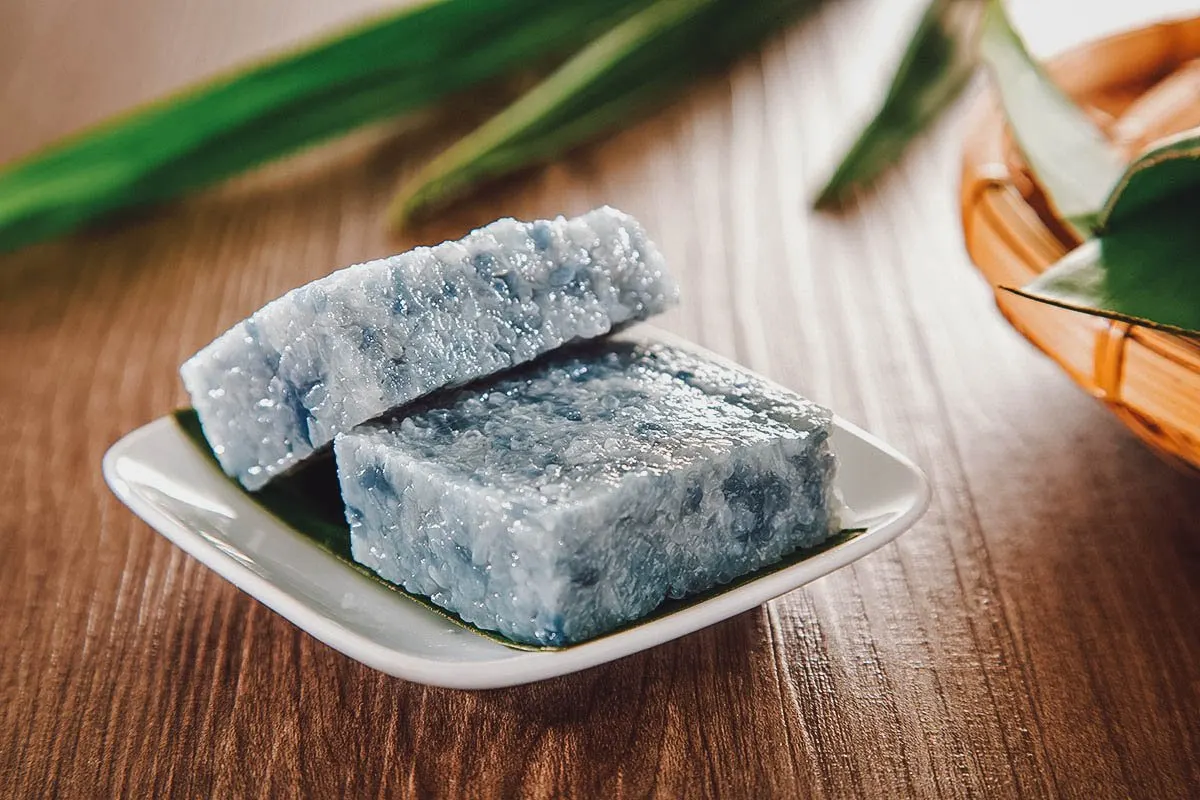
Photo by tehcheesiong
22. Kuih Dadar (Kuih Tayap)
These beautiful rolled crepes are known as kuih dadar or kuih tayap. They’re flavored with pandan juice and rolled around a filling of grated coconut steeped in palm sugar.
Nowadays, you can find kuih dadar made with artificial coloring but versions colored with pandan leaves are still the best. Not only do they look more natural, but they have that coconut-y, vanilla-like essence that you can only get from pandan.
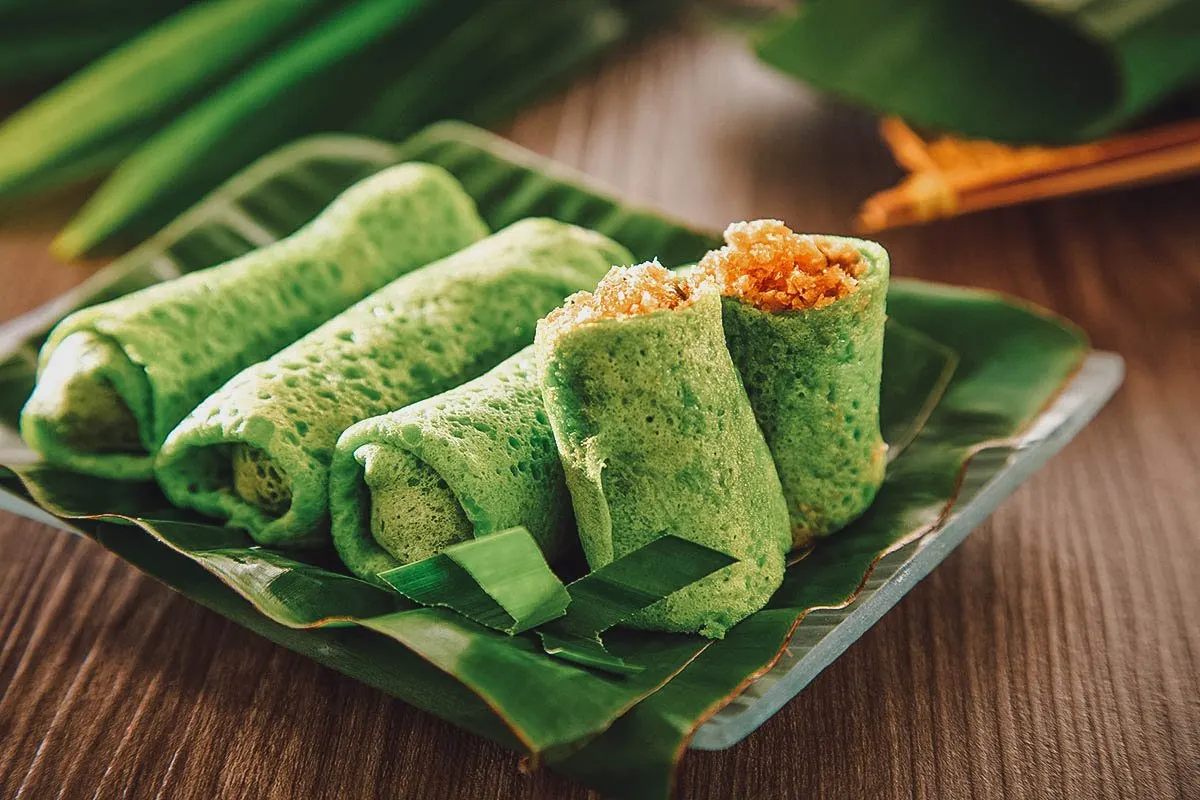
Photo by tehcheesiong
23. Kuih Bingka Ubi Kayu
Kuih bingka ubi kayu is another Nyonya/Peranakan tea-time favorite made with tapioca, eggs, coconut milk, and pandan leaves. Soft and slightly chewy, it’s a fragrant Malaysian dessert that’s relatively easy to make.
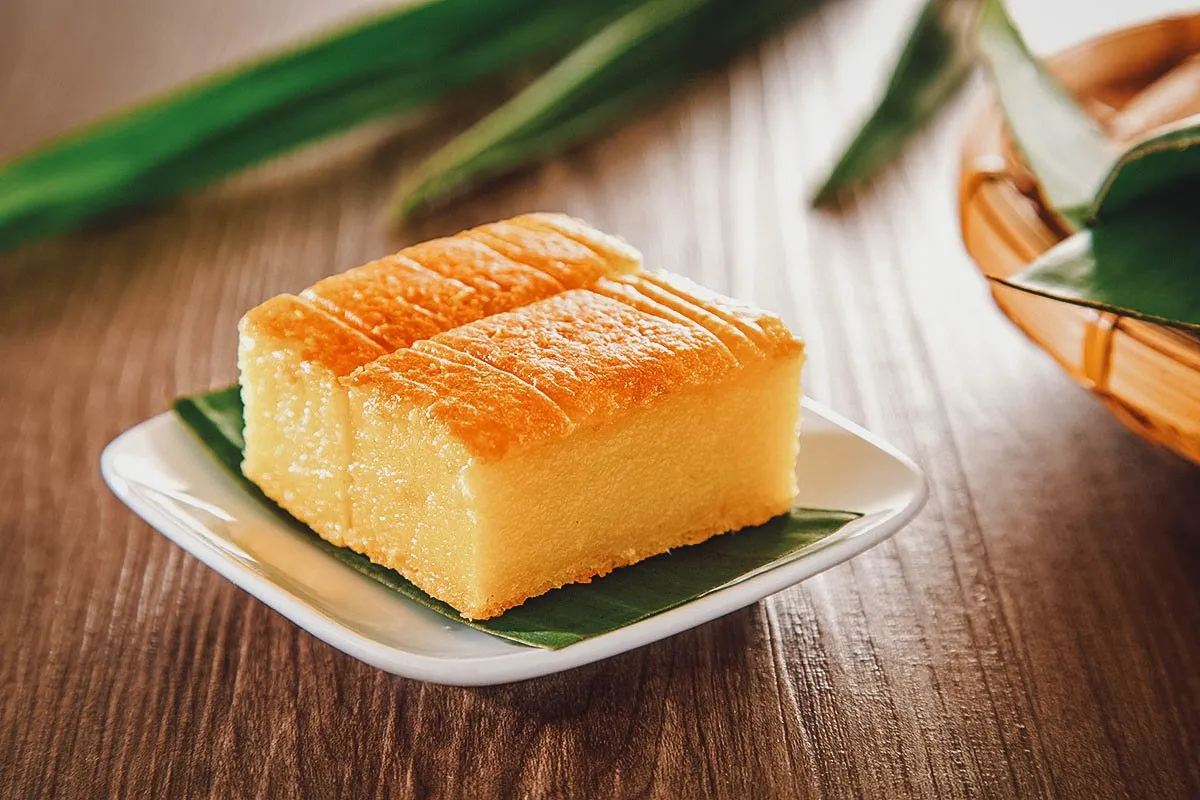
Photo by tehcheesiong
24. Kuih Ondeh-Ondeh
Google “best malaysian desserts” and you’ll surely come across these green balls coated in grated coconut. Not surprising considering how delicious they are.
Ondeh-ondeh (or onde-onde) consist of sweet potato or glutinous rice flour dough flavored with pandan juice and filled with gula melaka (palm sugar). The ping-pong-sized balls are boiled and then rolled in grated coconut before serving.
Bite into these beauties while they’re still warm and a burst of palm sugar syrup erupts into your mouth. They’re so good and easily one of my favorite Malaysian desserts.
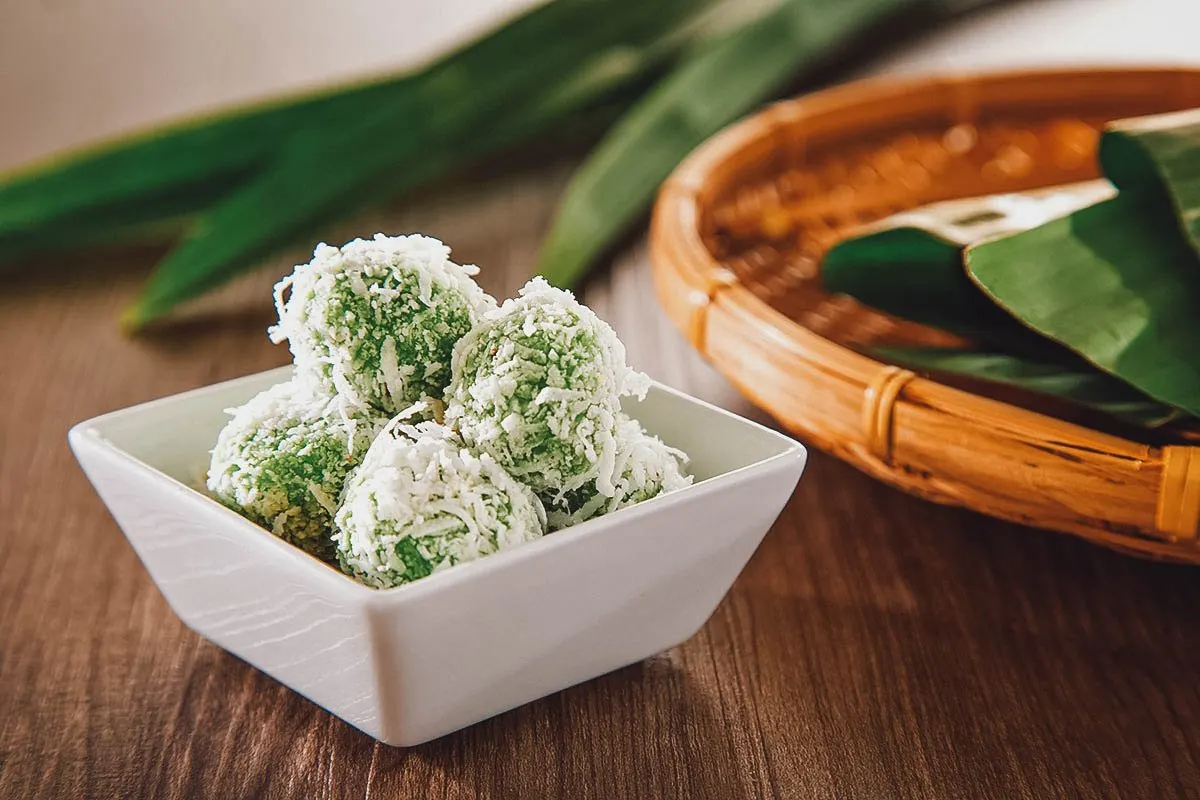
Photo by tehcheesiong
25. Kuih Kosui (Kuih Lompang)
Last on this list but certainly not least (especially to me), is kuih kosui. Also known as kuih lompang, it refers to a type of Malaysian steamed rice cake made with rice and tapioca flour flavored with pandan leaves and palm sugar.
If you’re familiar with Filipino kakanin, then you may recognize kuih kosui as the Malaysian equivalent to kutsinta. Kutsinta is one of my favorite Filipino snacks so it’s no surprise I have a soft spot for these bite-sized Malaysian cakes as well.
Like kutsinta, kuih kosui is typically enjoyed with a sprinkling of shredded coconut.
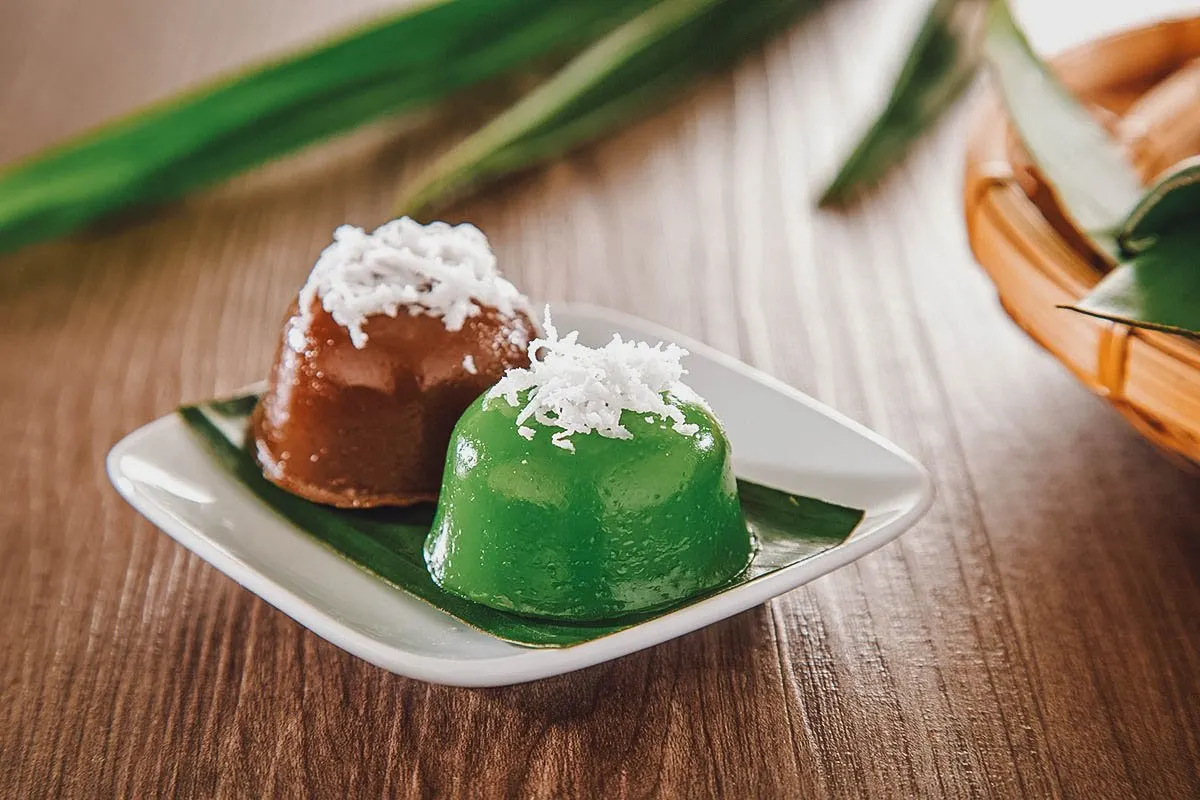
Photo by tehcheesiong
MALAYSIAN FOOD TOURS
Exploring the many desserts and dishes of Malaysia on your own is always fun, but if you’re interested in learning more about the cuisine, then you may want to join a guided tour.
Not only can a knowledgeable local take you to the city’s best markets, restaurants, and street food stalls, but they’ll be able to explain all the dishes to you in more detail as well. Check out Get Your Guide for a list of food tours in Malaysia.
MALAYSIAN COOKING CLASSES
Food tours are awesome, but if you want to really dive into Malaysian cuisine, then you may want to take a cooking class as well. Eating kuih is one thing, but learning how to actually make it yourself is another. Check out Cookly for a list of cooking classes in Malaysia.
FINAL THOUGHTS ON MALAYSIAN DESSERTS
If you find yourself confused by the concept of “kuih”, then you’re not alone. I’m confused by it too. As described, Malaysian kuih is similar to Filipino kakanin but the former seems to be a broader term.
Kuih literally means “cake” but it can also refer to different types of cookies, biscuits, pudding, donuts, dumplings, and pastries. They can be sweet or savory and cooked through steaming, baking, frying, or boiling.
Is rice the unifying factor? It may have been at one point, but not anymore. While most types of kuih are made with rice or glutinous rice, some can be made with other types of grain as well.
In my research to understand kuih, I found this excellent kuih guide which likens them to Japanese wagashi. I had never heard that comparison before but it’s actually a great way of describing them. No matter how or what they’re made with, kuih are colorful, bite-sized, and often artfully prepared confections usually enjoyed with tea, just like wagashi.
In any case, whatever their exact definition may be, just know that they’re delicious and you need to eat them as often as you can while in Malaysia.
Disclosure
Some of the links in this article on Malaysian desserts are affiliate links, meaning we’ll earn a small commission if you make a booking at no additional cost to you. We only recommend products and services that we use ourselves and firmly believe in. We really appreciate your support as it helps us make more of these free travel guides. Thank you so much!
Cover photo by tehcheesiong. Stock images via Depositphotos.


Lim Poh Leong
Monday 11th of September 2023
Keen on cooked desserts (red beans, green beans, “Dao Suan”, etc ) in vacuum packed . Thanks 😊